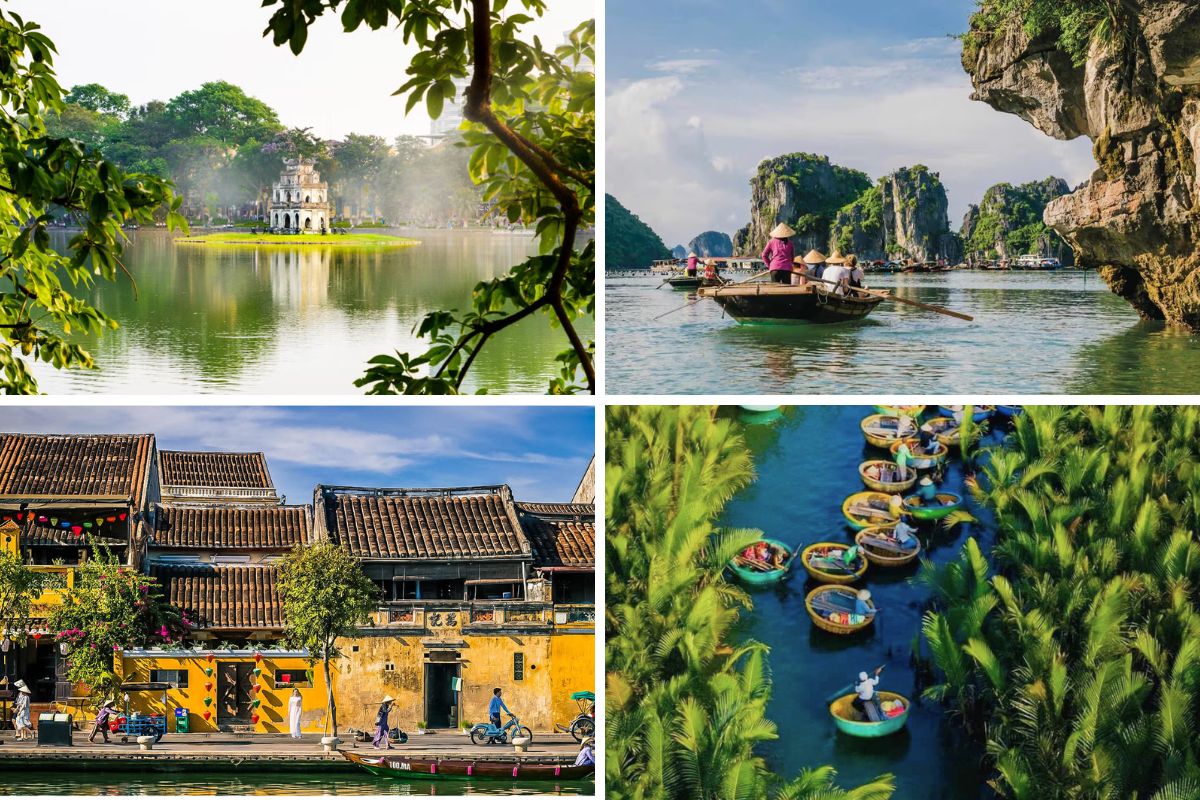TABLE OF CONTENT
Vietnam’s diverse climate and unique geography make timing a key factor in planning an unforgettable trip. The best time to visit Vietnam depends on what you hope to experience, as each region has its own seasonal patterns. This travel guide breaks down everything travelers need to know about Vietnam’s weather patterns and optimal visiting times throughout the year.

Vietnam Climate Overview
Vietnam’s climate is more complex than most travelers expect. While many picture a uniformly tropical country, the Vietnam climate actually varies dramatically from the mountainous north to the tropical south. Stretching over 1,000 miles from north to south, the country encompasses three distinct climate zones, each with its own ideal visiting periods.
Northern’s weather
The north, home to Hanoi, Halong Bay, and Sapa, experiences four seasons, including a winter that can be quite cool – a rarity in Southeast Asia. These seasons influence the best time to visit Vietnam’s northern regions.
- Spring (March to April): As winter fades, March and April bring mild, dry weather, making spring the best time to travel to North Vietnam. Blossoming flowers and fresh greenery create stunning landscapes, especially in mountainous areas like Sapa.
- Summer (May to August): The north’s summer is hot and humid, with monsoon rains that peak in July and August. While it’s less popular for travel, summer is great for adventurous visitors who enjoy the lush, green landscape.
- Autumn (September to November): With mild, dry conditions, autumn is ideal for sightseeing, and September through November is often considered the best time of year to visit Vietnam’s north.
- Winter (December to February): Northern Vietnam experiences a true winter, especially in high-altitude areas like Sapa, where temperatures can drop significantly.
Central’s weather
Central Vietnam, which includes Da Nang, Hoi An, and Hue, has a distinct tropical climate and an intense wet season. Choosing the best time to go to Central Vietnam is key for travelers interested in beach activities or exploring historical sites.
- Dry Season (February to August): The dry season, often considered the best time to visit Central Vietnam, is ideal for beach vacations. From February to August, temperatures are warm, skies are clear, and the ocean is calm, particularly in Hoi An and Da Nang.
- Rainy Season (September to January): During the rainy season, central Vietnam experiences heavy rain and even typhoons in some months. However, many cultural sites and historic cities are still enjoyable, with quieter crowds.

Southern’s weather
Southern Vietnam, encompassing Ho Chi Minh City and the Mekong Delta, experiences less seasonal variation, with warm tropical weather year-round. The south’s two main seasons – wet and dry – shape the best time to visit South Vietnam.
- Dry Season (November to April): The dry season is the best time to visit Vietnam’s southern region, particularly for beach destinations like Phu Quoc Island. Ho Chi Minh City is also pleasant, with less humidity and lower chances of rain.
- Rainy Season (May to October): The south’s rainy season features warm temperatures with regular afternoon showers, but the rains are usually short-lived, allowing plenty of time for sightseeing.
Vietnam weather by month
Vietnam’s weather varies greatly from month to month due to its distinct regional climates. Here’s a comprehensive breakdown of what to expect each month and help tourists find out the best time of year to visit Vietnam:
- January: This is the peak of winter in northern Vietnam, where temperatures can drop to around 15°C (59°F), especially in mountainous areas like Sapa. Central and southern Vietnam enjoys mild, dry weather, making it a perfect month for beach activities and outdoor sightseeing.
- February: Northern Vietnam remains cool and dry, though temperatures begin to warm slightly, with Hanoi around 17-20°C (63-68°F). Central and southern regions are ideal for travelers seeking sun and warm beaches, as they experience little to no rain.
- March: Spring arrives in the north, bringing mild weather with minimal rain. Central and southern Vietnam remain warm and sunny, making March one of the best time to travel to Vietnam overall, especially for those seeking a beach escape or trekking in the north.
- April: This month is warm across all regions, with increasing humidity and temperatures in the north. Central and southern Vietnam experience some of the best weather conditions for beaches, sightseeing, and nature activities.
- May: Summer approaches, bringing higher humidity and the start of the rainy season in southern and northern Vietnam. Central Vietnam remains relatively dry, and temperatures can soar, particularly in Hue and Da Nang.

- June: The monsoon season is in full swing in the north and south, with regular rains in the afternoons. Central Vietnam, however, is hot and dry, ideal for those looking to explore historic sites like Hoi An and Hue or relax on the beach.
- July: Northern and southern Vietnam continue to experience heavy rains and high humidity, while central Vietnam remains in its dry season. July is often a quieter travel month, suitable for those heading to central coastal areas.
- August: Monsoon rains are still present in the north and south. However, the rains are often short and refreshing, allowing for sightseeing earlier in the day. Central Vietnam remains mostly dry but starts to cool slightly as the season progresses.
- September: Rains decrease in northern and southern Vietnam, while central Vietnam begins its wet season, with occasional storms affecting beach destinations. For fans of nature and lush landscapes, September can still be a pleasant time to explore northern Vietnam.
- October: Northern Vietnam cools down, with temperatures becoming more comfortable and rains tapering off. Southern Vietnam is nearing the end of its rainy season. Central Vietnam sees heavy rains and possible typhoons, which can affect travel plans in beach areas.
- November: This month is one of the best times to visit Vietnam, with the north and south entering their dry seasons and central Vietnam beginning to dry out. November offers mild weather in the north and warm temperatures in the south, ideal for all kinds of activities.
- December: Winter arrives in the north, where temperatures drop, especially in mountainous areas. Central Vietnam has mild, dry weather, while southern Vietnam remains warm and sunny, making it a perfect month for both sightseeing and beach trips.
Best time to visit Vietnam by region
Best time to travel to North Vietnam
The best time to visit Vietnam’s northern are spring (March to April) and autumn (September to November). During these months, the weather is mild and dry, which is ideal for trekking in Sapa and cruising through Ha Long Bay. Sapa’s rice terraces display their most stunning colors during the September – October harvest season. Winter (December to February) can get quite cold, especially in the mountains, creating a misty atmosphere in Ha Long Bay but making for chilly treks in the northern highlands.
Best time to go to Central Vietnam
To explore Central Vietnam‘s historic cities and beaches, plan a visit between February and August. These months offer sunny weather and calm seas, ideal for both cultural sightseeing and beach activities. Hoi An’s ancient streets and Hue’s imperial sites are best explored during this period when rainfall remains minimal and temperatures stay manageable.
Best time to visit South Vietnam
The South welcomes visitors year-round, but the best time to visit Vietnam’s southern region spans December through April during the dry season. These months offer ideal conditions for exploring Ho Chi Minh City’s vibrant streets, venturing into the Cu Chi tunnels, and taking boat trips through the Mekong Delta’s intricate waterways.

Vietnam climate & weather FAQs
Does Vietnam have winter?
While southern Vietnam remains tropical year-round, northern regions do experience winter. In areas like Sapa, temperatures can drop below 10°C (50°F) during December and January.
When is monsoon season in Vietnam?
Monsoon season in Vietnam varies: northern and southern regions experience rains from May to October, while central Vietnam’s rainy season occurs from September to November. For many, the best time to visit Vietnam is outside these monsoon periods to avoid travel disruptions.
What is the temperature of Vietnam in December?
December temperatures in northern Vietnam can be chilly, especially in mountainous areas, while central and southern regions stay warmer. For those seeking cooler temperatures, December is a comfortable month for sightseeing.
How cold does it get in Vietnam?
Northern Vietnam can get quite cold during the winter months, especially in mountainous areas. In contrast, southern Vietnam remains warm year-round, with minimal temperature fluctuations, making it appealing for travelers looking for warm weather.
Vietnam from North to South for your best experience:
Vietnam’s climate diversity means that when one region experiences less favorable weather, another area likely offers perfect conditions. This variety allows for year-round travel opportunities, making Vietnam an accessible destination for travelers with different scheduling constraints and preferences. So there is no exact number to indicate the best time to visit Vietnam because at any time, this country can bring the most impressive experiences to every tourist.
—
If you’re looking for expert guidance to make the most of each destination, Asia Encounter brings a local touch and insider knowledge, crafting itineraries that turn travel dreams into vibrant, unforgettable adventures across Vietnam. Contact us today for more information!




